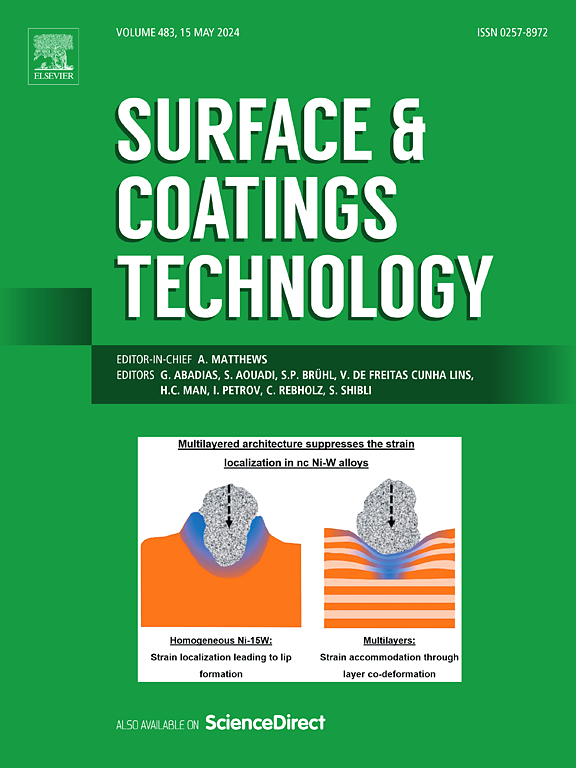氮化铬、类金刚石保护涂层与AISI 52100钢的磨损试验研究
IF 5.3
2区 材料科学
Q1 MATERIALS SCIENCE, COATINGS & FILMS
引用次数: 0
摘要
目前用于燃料润滑机械组件的硬氮化物和类金刚石碳(DLC)保护涂层必须适应更高的温度、负载和压力要求,以防止磨损,从而使未来的发动机能够在各种低润滑燃料下高效运行。在这项研究中,进行了载荷进展摩擦学实验,研究了三种涂层,氮化铬涂层,DLC涂层和DLC涂层在癸烷和乙醇燃料环境下的耐磨性。结果与基准材料AISI 52100钢进行了比较。多种表征技术,包括渐进负载划痕测试、光学显微镜、光学轮廓术、纳米压痕、扫描电子能谱和能量色散能谱,被用于揭示其性能的机制。DLC涂层在两种燃料环境下都会分层,暴露出下面的钢基板,随后在癸烷燃料环境中磨损。相比之下,CrN涂层在两种燃料环境下都保持粘附,有效地保护钢基体免受磨损。多层涂层由DLC涂层和CrN底层组成,在两种燃料环境下都能保持对钢基板的保护,同时还能减少滑动表面的摩擦和磨损。然而,在乙醇环境中,DLC层被磨损,留下CrN下层来保护钢基体。这些结果表明,CrN是一种很有前途的保护燃料润滑部件的候选材料。此外,将CrN下层与DLC涂层结合可以显著提高其摩擦和减少磨损的特性,使其适用于涉及乙醇燃料的应用。本文章由计算机程序翻译,如有差异,请以英文原文为准。
Experimental investigations of scuffing of chromium nitride and diamond-like carbon protective coatings and AISI 52100 steel
Hard nitride and diamond-like carbon (DLC) protective coatings currently used in fuel-lubricated mechanical assemblies will have to accommodate greater temperature, load, and pressure requirements to prevent scuffing wear enabling future engines to operate efficiently with various lower lubricity fuels. In this study, load progression tribological experiments were conducted to investigate the scuffing resistance of three coatings, a chromium nitride (CrN) coating, DLC coating, and DLC coating with a CrN underlayer in decane and ethanol fuel environments. The results were compared to the baseline material, hardened AISI 52100 steel. Multiple characterization techniques, including progressive load scratch testing, optical microscopy, optical profilometry, nanoindentation, scanning electron spectroscopy, and energy dispersive spectroscopy were used to uncover the mechanisms responsible for their performance. The DLC coating delaminated in both fuel environments, exposing the steel substrate underneath which subsequently scuffed in the decane fuel environment. In contrast, the CrN coating remained adhered in both fuel environments, effectively shielding the steel substrate from scuffing and wear. The multi-layer coating, composed of the DLC coating with the CrN underlayer, maintained protection of the steel substrate in both fuel environments while also reducing the friction and wear of the sliding surfaces. In the ethanol environment, however, the DLC layer was worn away, leaving the CrN underlayer to protect the steel substrate. These results indicate that CrN is a promising candidate for protecting fuel-lubricated components. Moreover, incorporating a CrN underlayer with DLC coatings significantly enhances their friction and wear-reducing characteristics, making them suitable for applications involving ethanol-based fuels.
求助全文
通过发布文献求助,成功后即可免费获取论文全文。
去求助
来源期刊

Surface & Coatings Technology
工程技术-材料科学:膜
CiteScore
10.00
自引率
11.10%
发文量
921
审稿时长
19 days
期刊介绍:
Surface and Coatings Technology is an international archival journal publishing scientific papers on significant developments in surface and interface engineering to modify and improve the surface properties of materials for protection in demanding contact conditions or aggressive environments, or for enhanced functional performance. Contributions range from original scientific articles concerned with fundamental and applied aspects of research or direct applications of metallic, inorganic, organic and composite coatings, to invited reviews of current technology in specific areas. Papers submitted to this journal are expected to be in line with the following aspects in processes, and properties/performance:
A. Processes: Physical and chemical vapour deposition techniques, thermal and plasma spraying, surface modification by directed energy techniques such as ion, electron and laser beams, thermo-chemical treatment, wet chemical and electrochemical processes such as plating, sol-gel coating, anodization, plasma electrolytic oxidation, etc., but excluding painting.
B. Properties/performance: friction performance, wear resistance (e.g., abrasion, erosion, fretting, etc), corrosion and oxidation resistance, thermal protection, diffusion resistance, hydrophilicity/hydrophobicity, and properties relevant to smart materials behaviour and enhanced multifunctional performance for environmental, energy and medical applications, but excluding device aspects.
 求助内容:
求助内容: 应助结果提醒方式:
应助结果提醒方式:


